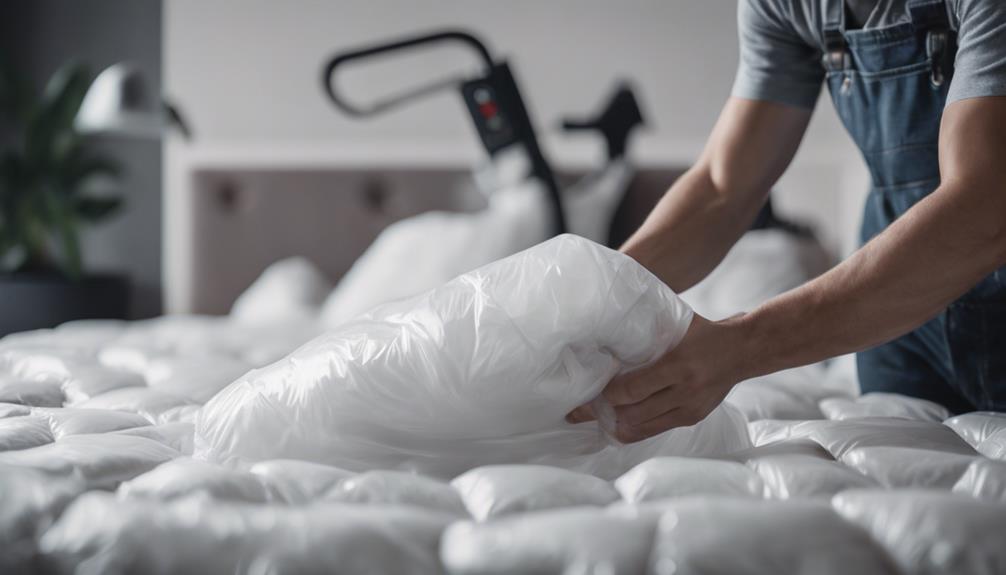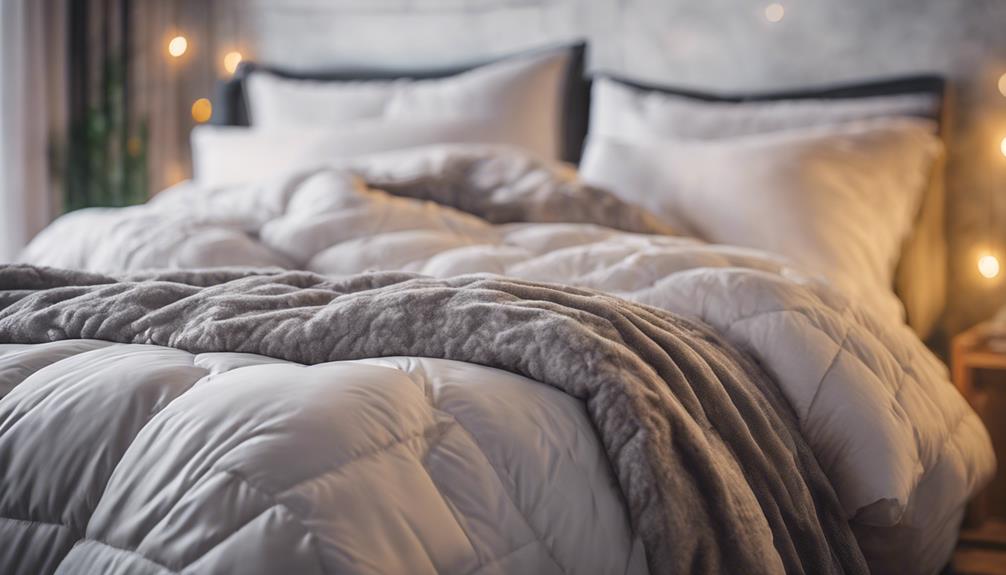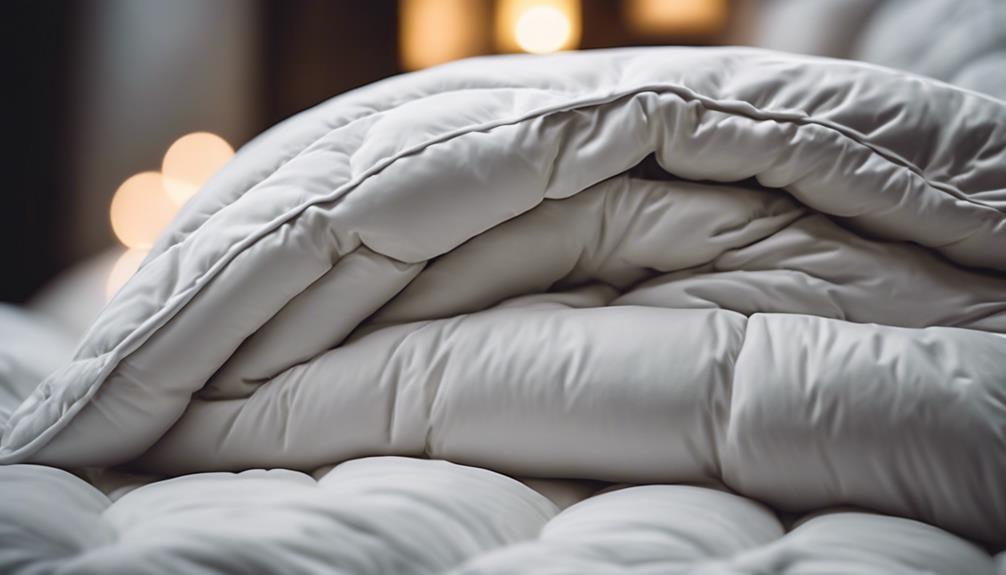Vacuum sealing a down comforter can potentially harm the delicate feathers, putting the loft at risk, causing clumping, and decreasing insulation efficiency. Compressing it may result in uneven distribution and compromised warmth retention. It’s best to steer clear of vacuum storage bags for down comforters to maintain their quality and longevity. Instead, opt for non-compressing storage solutions to preserve the fluffiness and optimal warmth of your comforter. Consider using breathable storage options such as cotton bags to prevent damage to the delicate feathers and ensure even warmth distribution. Learn more about properly caring for your down comforter for lasting comfort and quality.
Key Takeaways
- Vacuum packing can damage delicate feathers and reduce the loft and insulation of a down comforter.
- Compression can cause feathers to clump together, leading to uneven distribution and reduced warmth retention.
- Avoid vacuum packing to preserve the durability, fluffiness, and overall quality of the comforter.
- Brittle quills in feathers can snap under pressure, affecting the comforter's longevity and insulation.
- Opt for breathable storage solutions like cotton bags to maintain the optimal warmth and loft of a down comforter.
Potential Damage to Down Comforter
When vacuum packing a down comforter, it's important to be aware of the potential damage that can occur to the delicate feathers. Feather duvets are particularly vulnerable to harm when compressed in vacuum storage bags. The brittle quills in full feathers can easily snap under pressure, leading to a loss of loft and insulation in the bedding.
Additionally, squashing the tiny feathers in a down comforter can greatly reduce their effectiveness in retaining warmth. Using vacuum storage bags for down comforters may cause them to become lumpy and lose their fluffiness over time.
To preserve the quality and insulation properties of your feather duvet, it's best to avoid using storage bags that compress the feathers too tightly. Opting for breathable storage solutions that allow the down comforter to retain its natural loft and texture is essential in maintaining its comfort and longevity.
Impact on Fluffiness and Insulation
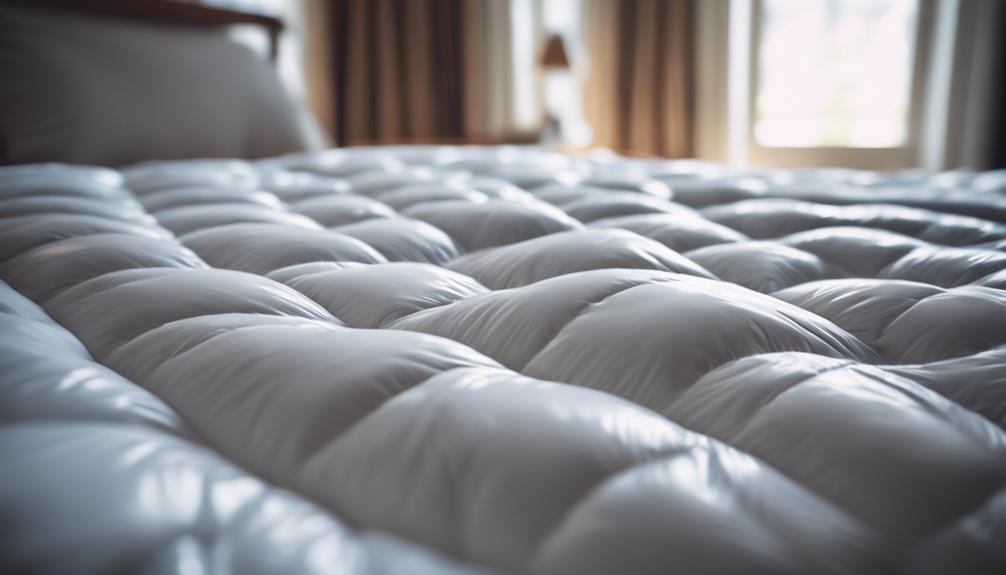
To maintain the fluffiness and insulation of a down comforter, guaranteeing vacuum packing is essential. When we compress feather duvets in vacuum bags, we risk damaging the delicate down feathers that provide warmth and coziness.
The compression from vacuum storage can cause the feathers to clump together, leading to a lumpy and uneven distribution within the comforter. This uneven distribution can result in certain areas being thinner and less insulating than others.
Over time, the repeated compression from vacuum packing can diminish the comforter's ability to trap heat effectively, reducing its overall fluffiness and insulation. To safeguard that your down comforter remains fluffy and retains its insulating properties, it's best to opt for non-compressing storage solutions that allow the feathers to remain lofty and airy.
Longevity and Quality Concerns
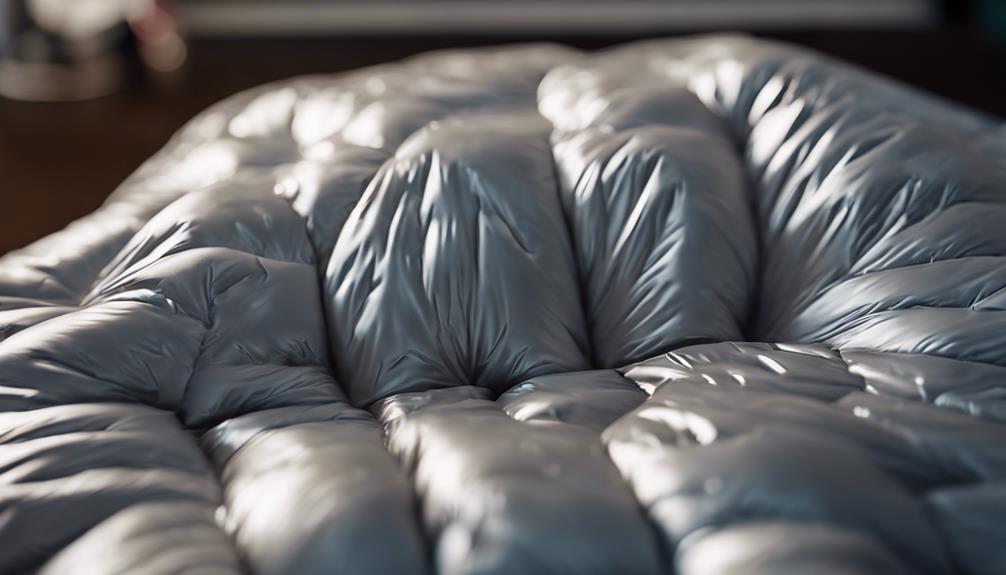
When vacuum packing a down comforter, it's crucial to take into account the potential impacts on longevity and quality. Compression from vacuum storage bags can lead to clumping of feathers and reduced loft, affecting the durability of the comforter.
Restricting airflow by vacuum packing may compromise the insulation properties, ultimately decreasing warmth and comfort.
Durability of Down
The longevity and quality of down bedding can be compromised when subjected to vacuum packing, as the delicate feathers may lose their fluffiness and insulation effectiveness. When full feathers in down comforters are compressed, their brittle quills can snap, affecting durability. Vacuuming down bedding can squash the tiny feathers that provide warmth, reducing insulation effectiveness. Additionally, feather duvets may develop lumps when vacuum packed, impacting their long-term quality and comfort. This damage to the delicate feathers can result in down bedding losing its fluffiness and warmth when vacuum sealed, ultimately affecting its longevity. It is advisable to avoid using vacuum storage bags for down comforters to prevent potential harm to the delicate feathers.
| Durability of Down | |
|---|---|
| Brittle Quills | Affect Durability |
| Reduced Insulation | Decreased Warmth |
| Lumps Formation | Decreased Comfort |
| Loss of Fluffiness | Reduced Longevity |
Impact on Fluffiness
Maintaining the fluffiness of a down comforter is essential for ensuring its longevity and quality. When vacuum packing a down comforter, the compression can damage the delicate feathers, impacting its ability to provide warmth and comfort.
Over time, the squashing of these tiny feathers may lead to lumps and uneven distribution within the comforter, affecting its overall fluffiness. This reduction in fluffiness not only diminishes the comforter's effectiveness but also shortens its lifespan.
To preserve the loftiness and quality of a down comforter, it's advisable to avoid vacuum packing and instead opt for breathable storage solutions that allow the comforter to retain its natural fluffiness and insulation properties without compromising on storage space.
Recommended Storage Methods
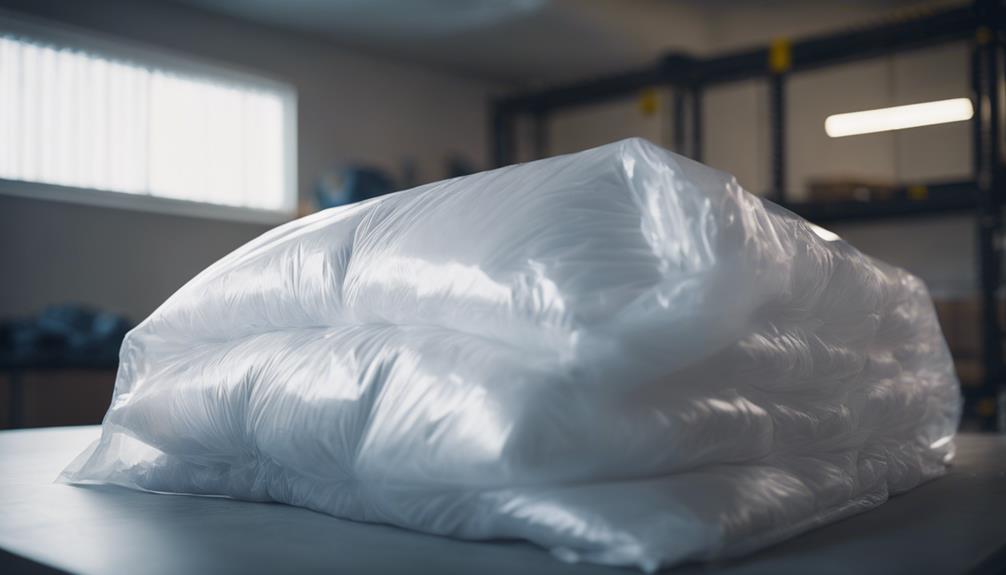
When storing a down comforter, it's crucial to use a large cotton bag to protect the feathers and prevent compression.
Avoid placing heavy objects on top of the comforter to maintain its fluffiness.
Proper Storage Conditions
For best preservation, consider storing down comforters in a breathable cotton bag to prevent feather damage and maintain loftiness. You can also use vacuum-sealed bags for synthetic or down alternative comforters, ensuring they are clean and dry before sealing. Here is a helpful table outlining proper storage conditions:
| Proper Storage Conditions | Description |
|---|---|
| Use a Cotton Bag | Prevents feather damage |
| Avoid Compression | Maintains loftiness |
| No Items on Top | Preserves fluffiness |
| Shake and Fluff After Storage | Re-ventilates down filling |
| Vacuum-Sealed Bags | For clean and dry comforters |
Following these storage methods will help maintain the quality and effectiveness of your down comforter.
Space-Saving Options
One space-saving option that can be considered is utilizing vacuum-sealed bags for down alternative comforters. These bags help reduce the size of the comforter by removing excess air, making it easier to store in tight spaces.
However, it's important to use bags specifically designed for bedding to prevent compression that can damage the fluffiness of the comforter.
Another option is to store the comforter in a plastic bag or acid-free box, ensuring it's clean and completely dry before storage to prevent mildew. Avoid storing down comforters in humid areas, as moisture can lead to mold growth.
Remember to follow the manufacturer's instructions and avoid compressing the comforter in a washing machine for long-term preservation.
Long-Term Preservation Tips
To maintain the quality and effectiveness of feather or down bedding, consider utilizing a large cotton storage bag. Avoid using vacuum storage bags for down bedding, as they can compress the feathers and reduce fluffiness and warmth.
Direct sunlight should be avoided when storing bedding, as it can cause damage over time. Additionally, storing bedding in a cool, dry place is vital to prevent mildew and unpleasant odors. Neusu's non-compressing storage bags are a good option for delicate bedding materials.
When vacuum packing bedding, make sure to leave 20-30% of air inside the bag to prevent damage. Proper storage of feather or down bedding is essential for long-term preservation and maintaining its quality.
Effects on Down Cluster Integrity
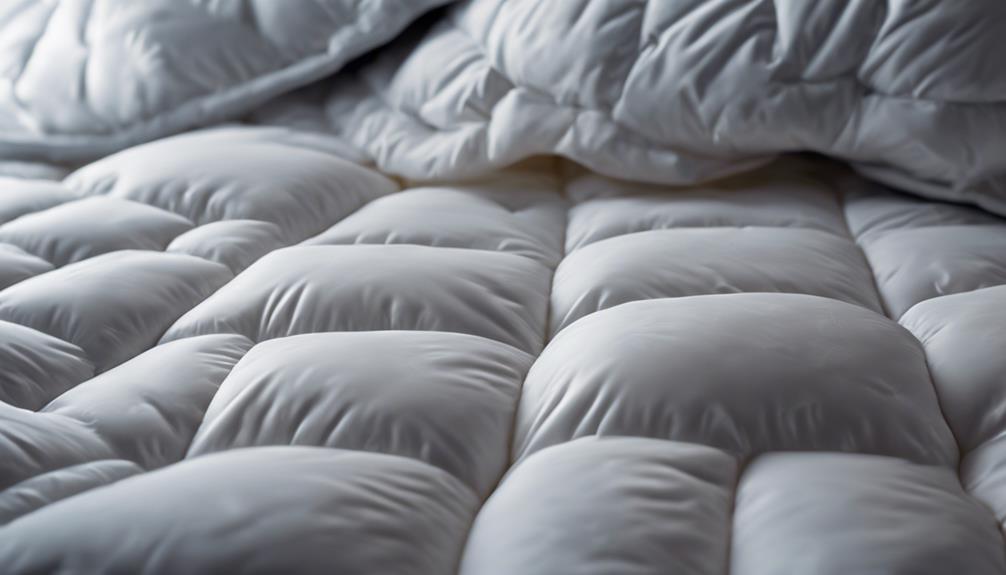
When vacuum packing a down comforter, the ideal performance of down clusters can be compromised, affecting their insulation properties. Down feathers are designed to trap air and provide warmth. However, the compression caused by vacuum sealing can damage these clusters, reducing their ability to keep you warm. To illustrate this further, let's consider the impact of vacuum packing on down clusters:
| Effect | Description | Outcome |
|---|---|---|
| Compression Damage | Squashes down clusters, impacting insulation | Reduced warmth |
| Clumping | Clusters stick together, losing fluffiness over time | Decreased loftiness |
| Structural Integrity Loss | Down feathers lose their natural shape and loft | Diminished insulation effectiveness |
| Long-Term Impact | Continual vacuuming can worsen these effects | Decreased comfort and warmth over time |
To maintain the ideal performance of your down comforter, avoid vacuum packing it and instead use breathable storage options to preserve its integrity and keep you cozy.
Preserving Optimal Warmth and Loft
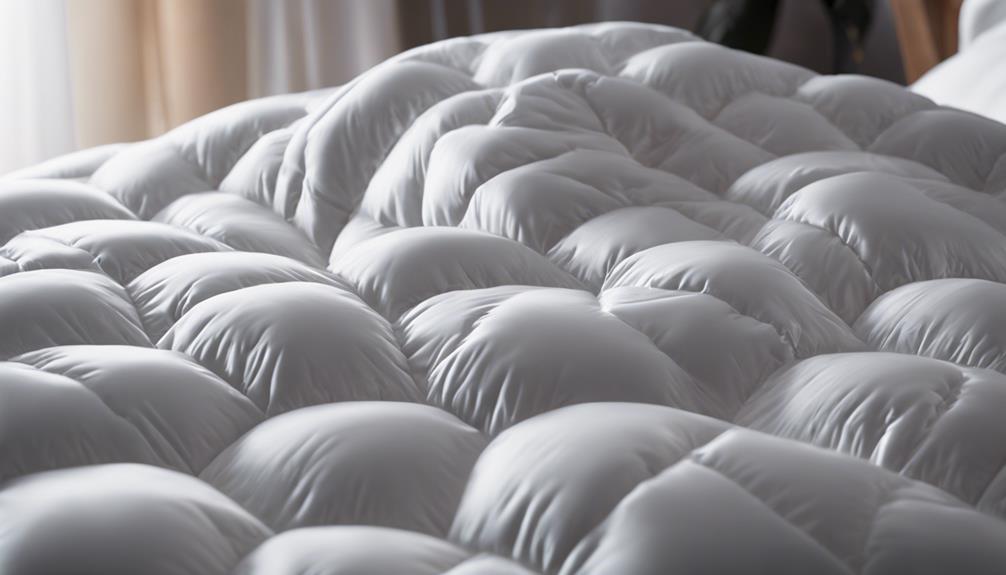
Preserving ideal warmth and loft in a down comforter involves avoiding vacuum packing, which can compress the feathers and diminish their insulation properties. When down clusters are compressed, their ability to trap air and provide warmth is compromised.
To maintain the fluffy and effective nature of a down comforter, it's best to stay away from vacuum packing and choose breathable storage solutions like cotton bags. These storage methods help prevent the delicate down clusters from clumping together and guarantee an even distribution of warmth.
Frequently Asked Questions
Can You Vacuum Bag a Down Comforter?
Yes, vacuum bagging a down comforter isn't recommended. It can harm the delicate feathers, reducing fluffiness and warmth.
The compression can break brittle quills and flatten the insulating tiny feathers, affecting its effectiveness. Lumping may occur, diminishing comfort and quality.
To maintain loftiness and longevity, avoid vacuum storage bags for down comforters. It's best to preserve these cozy essentials without sacrificing their quality and coziness.
Is It Okay to Vacuum Pack a Puffer Jacket?
Vacuum packing a puffer jacket can harm its insulation by compressing the fibers, reducing warmth and causing clumping. It's best to avoid vacuum packing to maintain the jacket's effectiveness.
Opt for proper storage methods like hanging or folding loosely instead.
What Is the Best Way to Store a Down Comforter?
Storing a down comforter properly is key to maintaining its quality. To store it well, use a large cotton bag to prevent feather damage and avoid placing heavy items on top.
After storage, shake and fluff the comforter to keep it fluffy. Remember not to vacuum pack it, as this can damage the feathers.
Consider using non-compressing storage bags like those from Neusu for safe and effective storage.
Can You Vacuum Pack Down a Sleeping Bag?
Vacuum packing a down sleeping bag can damage the delicate down insulation and reduce its loft and warmth. It's important to avoid compressing down items to maintain their effectiveness. Opt for non-compressing storage bags instead.
Proper storage methods are essential for preserving the quality of down sleeping bags. Remember, maintaining loft is key for best insulation.
Can Vacuum Packing Damage My Ugg Comforter?
Vacuum packing can potentially damage your Ugg comforter, especially if it is not stored properly. While washing the Ugg comforter in a machine is not recommended, vacuum packing can compress the fibers and affect the overall fluffiness and insulation of the comforter. It’s best to store it in a breathable bag instead.
Conclusion
In conclusion, vacuum packing a down comforter can potentially damage its fluffiness, insulation, and overall quality. It may compromise the integrity of the down clusters, leading to a decrease in warmth and loft over time.
To preserve your comforter's optimal performance, it's recommended to store it in a breathable cotton storage bag or large pillowcase instead. Remember, proper storage is key to keeping your down comforter cozy and comfortable for years to come.
